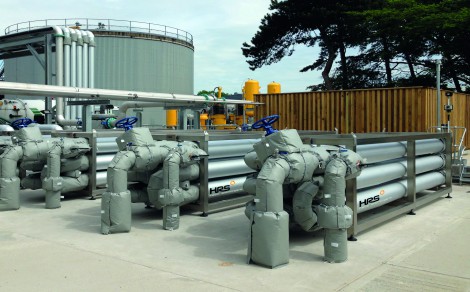- Home » Editorial » Hydraulics
Spiral or corrugated tube heat exchangers – which is best for wastewater treatment?

Newer designs do not have the same support framework to separate the coils as some older models, as such structures were ideal at picking up rags and fibres from the sludge, leading to further blockages and a consequent reduction in heat exchange efficiency. As a result, manufacturers of SHEs also claim that their units are easy to clean. However, it is not uncommon to have to remove 40-50 bolts just to open the unit. Once opened, the construction means that the service fluid channel contains a large number of brackets which not only give the heat exchanger its rigidity but make cleaning difficult in sludge-to-sludge situations. There is also the issue of the expensive bespoke gaskets which are used to seal SHEs, and which need to be replaced each time the cover is refitted.
Manufacturers of SHEs know that users don’t want to remove 50-odd bolts before they can clean the unit, (and have to do them all up to the correct torque again.) They also acknowledge that many materials, such as sewage sludge, require frequent cleaning. To overcome this, they produce SHE models with hinged covers, which are held shut with C-clamps, so you don’t have to undo the bolts. While this type of design improves access, it increases the amount of space required for the installation and contradicts claims of SHEs being self-cleaning.
By contrast, the corrugated tubular design of the HRS DTI Series reduces fouling in a number of ways. The tube-in- tube design offers much larger channel than spirals, thereby reducing blockages. The corrugated inner tube also encourages turbulence, which increases heat transfer and reduces fouling – the very reason why HRS uses corrugated tubes. The tubes within the DTI Series are easy to clean and maintain. Removable bends make the tubes very easy to access, and there are no expensive gaskets to replace.
HRS has been asked by numerous clients to replace their existing SHEs because of significant problems with fouling, maintenance and repair; all of which lead to extended periods of downtime and overall poor performance.
Compact design
A hinged, clamped cover may make it easier to clean the supposedly self-cleaning SHE, but it also means that the cover has to have the room to open outwards. Finding room to accommodate this immediately increases the space required for an SHE installation.
It is also worth remembering that SHEs come in various shapes and designs and that many of the larger units are no more compact than other designs, such as those based on tubular heat exchangers.
Other benefits of corrugated double-tubes
While some of the benefits claimed for SHEs hold true when they are compared to smooth tubular heat exchangers, the benefits diminish when compared to corrugated tubes of the type used by HRS Heat Exchangers, in the DTI Series.
-
Farnborough International Airshow
22 - 26 July, 2024
Farnborough International Exhibition & Conference Centre










